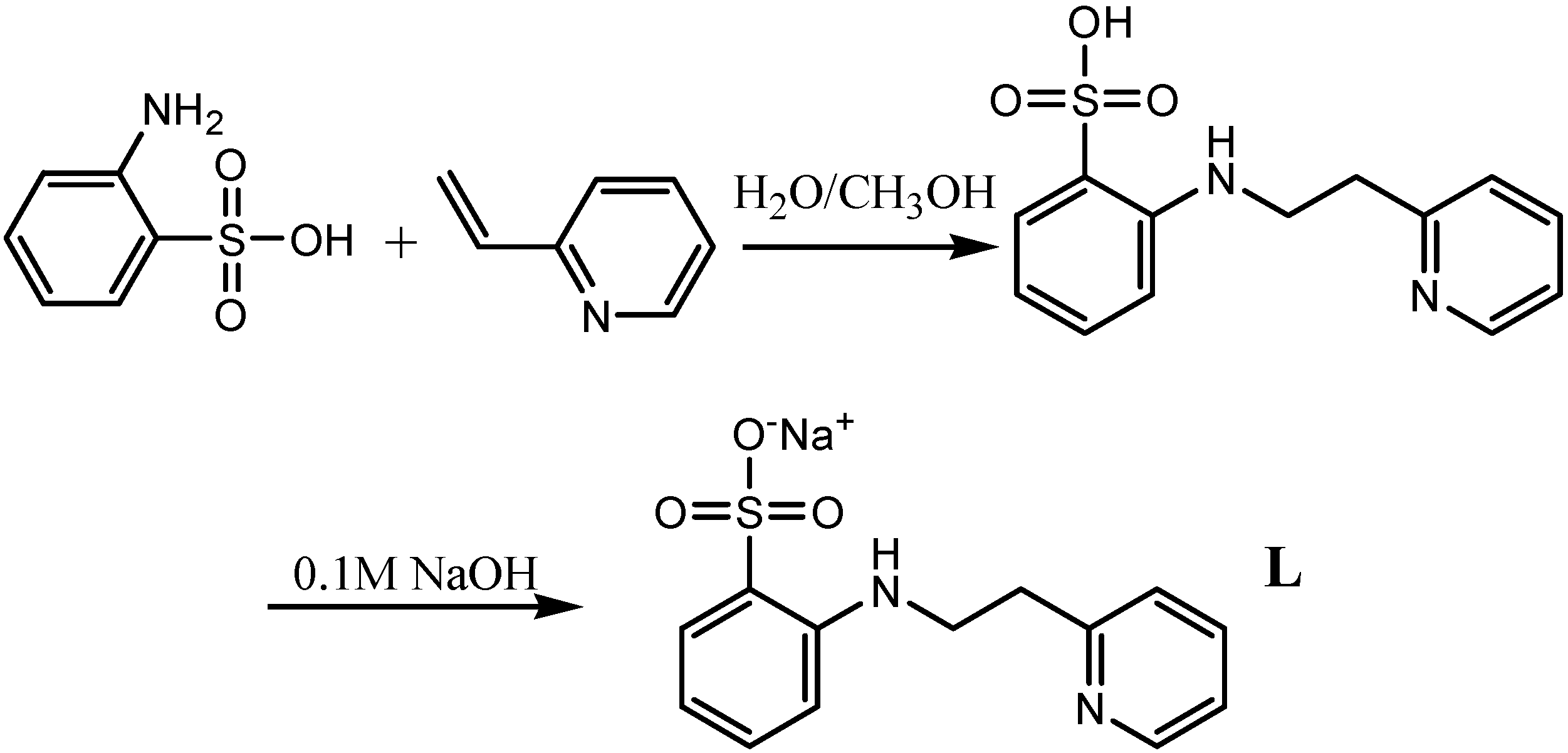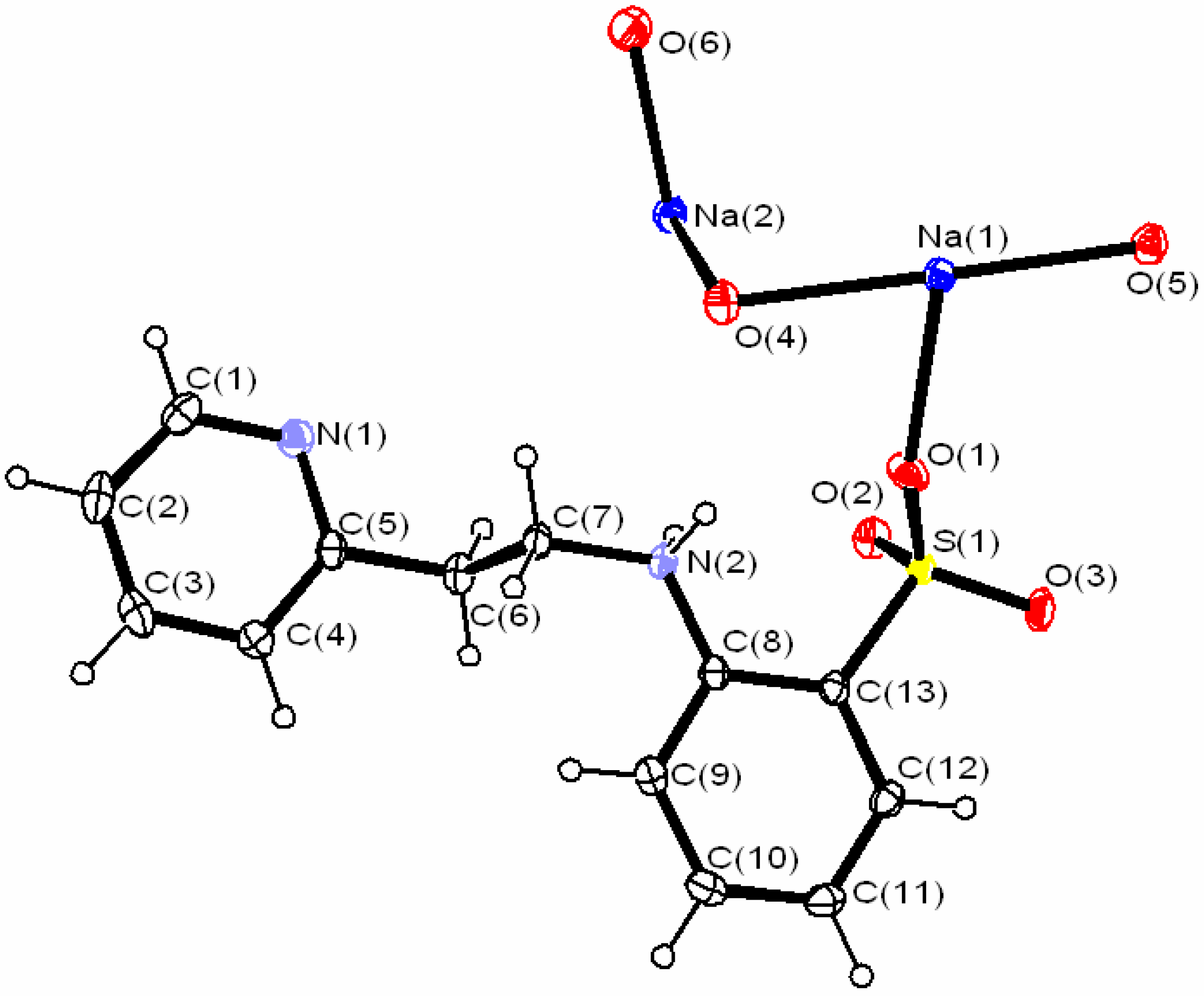Synthesis and Structural Characterization of the Sodium Salt of a New Sulfonate-containing Water Soluble N-Donor Ligand⎯ Self-assembly in the Solid State by π−π Stacking Interactions
Abstract
:Introduction

Results and Discussion


Conclusions
Experimental
General
Synthesis of L
X-ray Crystal Structural Determination [11].
| Parameter | L |
|---|---|
| Empirical formula | C13H13N2O3SNa |
| fw | 300.30 |
| temp (K) | 273 (2) |
| radiation (Å) | 0.71073 |
| cryst syst | Orthorhombic |
| space group | Pbcn. |
| cell constants | |
| a (Å) | 31.930(13) |
| b (Å) | 7.105(3) |
| c (Å) | 14.193(6) |
| α (deg) | 90.00 |
| β (deg) | 90.00 |
| γ (deg) | 90.00 |
| V( Å3) | 3220(2) |
| δ calcd(g/cm3) | 1.394 |
| Z | 9 |
| abs coeff (mm−1) | 0.9371 |
| F (000) | 1404 |
| cryst size (mm3) | 0.21×0.14×0.15 |
| θ range (deg) | 1.28−27.79 |
| h,k,l ranges collected | −40≤ h≤40 −9≤ k ≤9 −18≤ l ≤ 18 |
| no. reflns collected | 3762 |
| no. unique reflns | 3134 |
| Completeness | 98.7% |
| abs correction | Empirical |
| Refinement method | Full-matrix least-squares on F2 |
| No. of params | 209 |
| Data/param ratio | 18.00 |
| GOFwc | 1.104 |
| Final F induces [I > 2σ(I)] | R1a = 0.0452 wR2b = 0.1363 |
| R indices(all data) | R1 = 0.0552 wR2 = 0.1486 |
| aR1=Σ||F0| - |FC||/Σ|F0|. bwR2=|Σ|F0|2 - |FC|2|/Σ|w(F0)2|1/2. | |
| w =1/[(F02)2+(0.1276P)2+2.6903P], where P=(F02+Fc2)/3. | |
Acknowledgments
References
- Kalck, P.; Monteil, F. Adv. Organomet. Chem. 1992, 34, 219–284.
- Herrmann, W. A.; Kohlpaintner, C. W. Angew. Chem. Int. Ed. Engl. 1993, 32, 1524–1544.
- Liang, H.-C.; Das, S. K.; Galvan, J. R.; Sato, S. M.; Zhang, Y.; Zakharov, L. N.; Rheingold, A. L. Green Chem. 2005, 7, 410–412.
- Schmuck, C. Angew. Chem., Int. Ed. Engl. 2003, 42, 2448–2451.
- Oh, K.; Jeong, K.-S.; Moore, J. S. Nature 2001, 414, 889–893.
- Janiak, C. J. Chem. Soc., Dalton Trans. 2000, 3885–3896. [CrossRef]
- Amabilino, D. B.; Stoddart, J. F. Chem. Rev. 1995, 95, 2725–2828. [CrossRef]
- Claessens, C. G.; Stoddart, J. F. J. Phys. Org. Chem. 1997, 10, 254–272.
- Nelson, S. M.; Rodgers, J. Inorg. Chem. 1967, 6, 1390–1395.; Karlin, K. D.; Haka, M. S.; Cruse, R. W.; Meyer, G. J.; Farooq, A.; Gultneh, Y.; Hayes, J. C.; Zubieta, J. J. Am. Chem. Soc. 1988, 110, 1196–1207.
- March, J. Advanced Organic Chemistry: Reactions, Mechanisms and Structure, 4th ed.; Wiley: New York, 1992; pp. 411–413. [Google Scholar]
- CCDC-282737 contains the supplementary crystallographic data for this paper. These data can be obtained free of charge via the URL http://www.ccdc.cam.ac.uk/conts/retrieving.html (or from the CCDC, 12 Union Road, Cambridge CB2 1EZ, UK; fax: (+44) 1223 336033; e-mail: [email protected]).
- Sample Availability: Available from the authors.
© 2006 by MDPI (http:www.mdpi.org). Reproduction is permitted for noncommercial purposes.
Share and Cite
Zhang, Y.; Liang, H.-C. Synthesis and Structural Characterization of the Sodium Salt of a New Sulfonate-containing Water Soluble N-Donor Ligand⎯ Self-assembly in the Solid State by π−π Stacking Interactions. Molecules 2006, 11, 163-168. https://doi.org/10.3390/11020163
Zhang Y, Liang H-C. Synthesis and Structural Characterization of the Sodium Salt of a New Sulfonate-containing Water Soluble N-Donor Ligand⎯ Self-assembly in the Solid State by π−π Stacking Interactions. Molecules. 2006; 11(2):163-168. https://doi.org/10.3390/11020163
Chicago/Turabian StyleZhang, Yonglian, and Hong-Chang Liang. 2006. "Synthesis and Structural Characterization of the Sodium Salt of a New Sulfonate-containing Water Soluble N-Donor Ligand⎯ Self-assembly in the Solid State by π−π Stacking Interactions" Molecules 11, no. 2: 163-168. https://doi.org/10.3390/11020163




